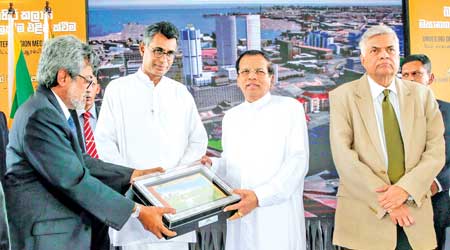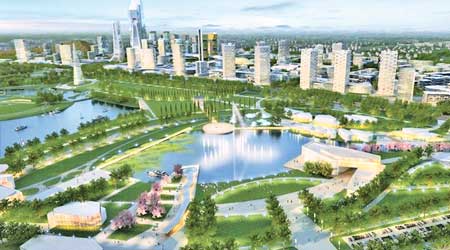The megapolis promise
by Ranil Wijayapala
The initial stage of the megapolis plan got under way on Friday with
the launch of the structural plan for the Western Megapolis Development
Project, the first of its kind in the country. It is is expected to be
completed by 2030.
 |
|
Ajita de Costa, Chairman
of the Megapolis Planning Project (extreme left), Megapolis and
Western Development Minister Chamipika Ranawaka, President
Maithripala Sirisena and Prime Minister Ranil Wickremesinghe at
Friday’s launch.
Pic : Sudath Silva |
The launch marked the completion of the first phase of the mega
development drive to be expanded in the next 15 years, with investments
over 40 billion US dollars.
The flagship development project was launched in April last year,
with the setting up of an office to make structural plans for the mega
development drive, aiming to take the country out of the messy
urbanisation trap and creating the much-needed spatial structure to
achieve economic prosperity by 2030. President Maithripala Sirisena and
Prime Minister Ranil Wickremesinghe marked the launch by planting a 'Na'
sapling at Independence Square, symbolising the rise of the nation,
similar to the growth of trees.
Although the plan was launched, the people are still in the dark
about the mega development drive. Megapolis and Western Development
Minister Chamipika Ranawaka said an urban area with a population of more
than five million is known as a 'Megapolis' and transforming the Western
Province with a population of six million into a well-planned enclave
will get under way and will be known as the Western Region Megapolis
Development Project.
Legal entity
Although the structural plan has been launched, the process is yet to
be set up as a legal entity. A Megapolis Authority, similar to the
Mahaweli Authority will be set up by an an Act of Parliament. The
approval for the master plan is also expected to come from Parliament.
"To complete this legal process, we have prepared the documents and
would present it to Parliament during the first half of this year," the
Ranawaka said. The implementation will include, investment briefings and
lobbying for investments.
"These parallel activities have begun. We have begun lobbying for
investments through the Transport Ministry, Highways Ministry and
Provincial Councils for the implementation of the projects," he said.
The megapolis development drive is mainly to address the messy
urbanisation issues in the Western Region, which was a setback.
Addressing these issues will create the much-needed spatial structure
for future growth, enabling high income levels and economic prosperity
by 2030.
 |
|
Blueprint of the Megapolis
project ANCL Media Library |
Issues of stray cattle and stray dogs to slum dwellers, waste
management, housing and transport, directly related to urbanisation will
be addressed.
"It is not a question of having the sitting room tidy, while the
kitchen and toilets stink. It will not be an effort to decorate the city
but to develop inner areas", he said.
Fine example
"They will be implemented as a single entity.The earlier development
projects were also aimed at achieving economic prosperity but the
difference is these projects will be implemented as a single entity,"
Ranawaka said. The inclusion of the Colombo Port City project as part of
the Marine City is n fine example," he said.
The megapolis development drive will be different from earlier
development projects. All projects will be implemented with the consent
of the people and are aimed at achieving economic benefit.
"Steps will be taken to ensure a participatory approach," he said.
Projects with no economic benefit will be stalled. The floating
market which is not economically viable will not be included. Jogging
tracks, although beautiful do not generate any income and will be
halted.
The Minister ensured that when contracts are being awarded, they will
be given on a competitive basis."The Megapolis is based on economic
prosperity, social justice, environmental sustainability and the
people's quality of life.
"We will develop a zoning system to mark residential zones and
economic zones," he said. According to the structural plan, zones will
be demarcated for development projects.
Accordingly the Marine City which includes the Port City around the
Colombo Port area, the Aero City in Katunayake and Minuwangoda, a
Logistic City connecting Wattala, a Central Business District from
Pettah, Slave Island to Kollupitiya, a Tech City in Homagama and Malabe,
two Industrial Cities in Horana and Meerigama, two Tourist Cities in
Negombo and Beruwala, a Plantation City in Avissawella, a Green City in
Baduraliya, adjacent to the Sinharaja forest and an Administrative City
in Sri Jayewardenapura will be set up.
The existing projects should harmonise with the structural plan.
"Some will be included, while others will be rejected. Some will be
reconciled with our new concepts. We will request rejected projects to
change their scope and harmonise with the megapolis plan. The Port City
Project is one such. "As people need an immediate solution for existing
issues, there will be short-term solutions to address issues such as
transport. These issues have been plaguing the country for some time. We
plan to provide solutions by 2020", he said.
"Some people would have to be relocated and the government would
provide solutions. The benefits are great and it will have a positive
impact on the community.
As for the Mahaweli Project, it is a classic example of a project
having a negative impact on the country, " he said. According to the
structural plan, 150 projects have been identified and requires at least
US $ 40 billion to be implemented in the 15-year period, from 2016 to
2030.
No economic return
The government is expected to invest on infrastructure development
projects such as railway, highway, water supply and drainage.
"The previous government invested over US dollars six billion on the
Hambantota District alone but there is no economic return. If they had
invested that money in Colombo, there would have been heavy returns, "he
said.
"The private sector could invest in housing projects for the middle
class and develop commercial centres. We can give them the land for
housing projects. Foreign governments too could invest.
"China and Japan are engaged in the Port City Project and in
improving the Bandaranaike International Airport," he said.
"When President Sirisena visits Germany and Japan in the next two
months, we will invite foreign investors to invest in projects
identified in the plan. We will also invite India, Korea, China, the
Middle East and European countries to invest," he said. |

